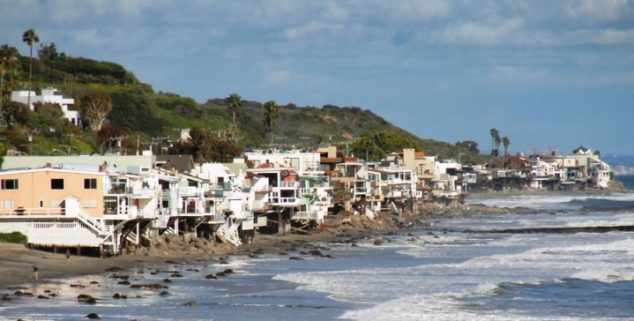News
Sea level rise: California’s new reality
 Pacific Ocean waves lap against beach front properties in Malibu. (Photo: Elliott Cowand Jr., via Shutterstock)
Pacific Ocean waves lap against beach front properties in Malibu. (Photo: Elliott Cowand Jr., via Shutterstock)While wildfires have gotten much of the attention in California as consequences of climate change, it’s really rising sea levels that will likely wreak the most damage.
With more than 25 million people living near the coast, some $150 billion worth of property is at risk.
“This is really an existential threat,” said Half Moon Bay Mayor Harvey Rarback. “We have to be provident and prepare for it and it’s going to be expensive. Literally putting your head in the sand is not going to work.
The state coastal commission recently warned beach communities to prepare for the ocean to rise up to 10 feet by 2100.
Melting ice in Antarctica and Greenland and warming sea temperatures are causing sea levels to rise rapidly around the world. In the most extreme case, the tiny central Pacific Ocean island nation of Kiribati, home to 116,000 people, is becoming submerged by the sea now. The waves are creeping right up to the main highway and have already destroyed seawalls. Residents are already starting to immigrate elsewhere and more are expected to become “climate refugees.”
California hasn’t gotten to that place yet but the state Coastal Commission recently warned beach communities to prepare for the ocean to rise up to 10 feet by 2100. The problem is serious enough that the commission has asked all coastal cities to make plans for “managed retreat”– moving buildings and infrastructure away from coastline before the ocean submerges them.
Coastal communities are already contending with higher ocean waters.
Earlier this month, a coastal bluff in Encinitas collapsed killing three women. The L.A. Times reported that communities should expect more cliff failures along the coast as a result of rising sea levels.
Pacifica continues to face shrinking beaches and ordered the demolition of three apartment buildings on an eroding cliff following storms in 2016.
Del Mar, where beachfront homes run from $1.5 million to $25 million, has rejected the policy and is digging in.
Half Moon Bay’s sewer plant is right on the ocean and is threatened, Rarback said. “I’m sure in 20 years, it’s going to be underwater,” he said. “We have to plan for that and that’s going to be really expensive. It has to be taken seriously.”
Assemblymember Mark Stone said the city of Santa Cruz, which is in his district, has a very old water delivery system and water treatment plant that is going to be subject to flooding during big storm events caused by rising sea levels. Other coastal water systems in the state are old and falling apart. While the state did a good job with legislation to fund road repairs, it hasn’t done the same for water systems, he said. To date, Stone said, the state has not adequately addressed rising sea levels.
Stone is trying to help change that with his Assembly Bill 552, which would direct 30 percent of revenues from oil extraction on state-owned tidelands toward planning and implementation of climate adaptation projects on the state’s coast. The money that would be available is estimated at $26.15 million annually. “It’s fairly flexible money if we can get this passed,” he said.
But some coastal communities don’t want to think about managed retreat quite yet. Del Mar, where beachfront homes run from $1.5 million to $25 million, has rejected the policy and is digging in.
“It’s not a future threat like people keep talking about. It’s happening right now.” — Harvey Rarback
Mayor David Drucker said all the ocean front properties are protected by seawalls and are more than eight feet above sea levels and protect lower level homes to the east of them. “If we got rid of these houses, any waves would inundate low lying areas,” he said.
Moreover, because Del Mar is so small, there is nowhere to move those beach front homes. “If we had managed retreat, the houses would be gone, the property values would turn to zero and there would be nowhere where people could rebuild,” Drucker said.
Through sand replenishment and building a levee, the community is hoping to save the homes for at least the next 50 years. “In 50 years, of course, all bets may be off,” he said. “Or maybe we will have reversed sea level rise or maybe we will have an engineering solution that will protect all the houses in Del Mar,” he said.
The community’s attitude is not a denial of climate science, Drucker said. Building zoning in the town was devised by the late Charles David Keeling, who identified the problem of human contribution to global warming, and who created the “Keeling Curve,” which measures carbon dioxide in the atmosphere.
Rarback, the Half Moon Bay mayor, said communities can’t wait anymore to address rising seal levels.
“It’s not a future threat like people keep talking about,” he said. “It’s happening right now.”
Want to see more stories like this? Sign up for The Roundup, the free daily newsletter about California politics from the editors of Capitol Weekly. Stay up to date on the news you need to know.
Sign up below, then look for a confirmation email in your inbox.

Leave a Reply